Dwarf or Small Cherry Blossom Trees (With Pictures) – Including Care Guide
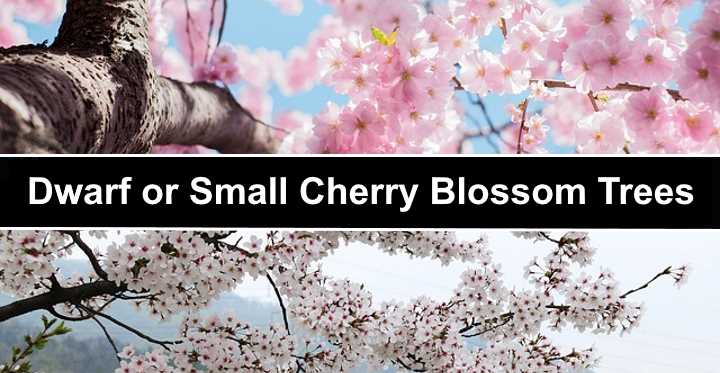
Dwarf cherry blossom trees are stunning flowering trees with pink or white flowers, perfect for small or large garden landscapes. Pink and white cherry blossom trees bloom in spring, filling gardens with sweet fragrances and beautiful showy flowers. The small ornamental cherry blossom trees create shade in the summer with their green foliage before turning shades of yellow, bronze, and orange in the fall.
Dwarf flowering cherry trees typically grow around 8 ft. – 10 ft. (2.4 – 3 m) tall. Some miniature cherry blossom trees are smaller varieties of larger cherry trees. Other mini cherry trees, such as the sakura cherry blossom (Prunus serrulata ‘Kiku-Shidare-Zakura’), are dwarf ornamental weeping cherry trees.
Small or dwarf cherry trees are generally low-maintenance flowering trees. Their short stature or weeping growth doesn’t require pruning to control height. Typically growing in USDA zones 5 through 8, you can easily grow a stunning dwarf cherry blossom tree in full sun and well-drained, fertile soil.
This article is a guide to the most popular dwarf or small cherry blossom trees. At the end of the article, you’ll find a handy care guide for growing small flowering cherry trees in your front or backyard.
What are Small or Dwarf Cherry Blossom Trees?
Dwarf cherry blossom trees belong to the flowering tree genus Prunus. Also called small ornamental cherry trees, the cherry tree cultivars are prized for their stunning spring pink or white blossoms. Ornamental cherry trees are slow-growing and thrive in USDA zones 5 through 8 or sometimes 9.
Small cherry blossom trees also go by the names Japanese cherry tree or Sakura. In many places, ornamental cherry blossom trees or their flowers are simply referred to as sakura. The name sakura also appears in the botanical names of many Japanese cherry blossom trees.
Dwarf cherry flowering trees usually bloom between March and April. When the clusters of showy flowers open, the small flowering trees explode into shades of pinks and whites. Some dwarf flowering trees have so many scented flowers that the whole tree looks white or pink.
The floral scent of cherry blossoms has a delicate aroma of roses. Depending on the species, some sakura (cherry blossoms) have overtones of almond, vanilla, or sweet cherries.
The difference between cherry blossom trees and other cherry trees is their fruit. Typically, dwarf cherry blossom trees produce clusters of small cherries. The small fruits are inedible due to their sour taste and size.
How Tall Do Dwarf Cherry Trees Get?
Dwarf flowering cherry trees typically grow between 6 and 10 ft. (1.8 – 3 m) tall and 2 to 15 ft. (0.6 – 4.5 m) wide. The height of small ornamental cherry trees contrasts with the larger flowering cherry blossom trees that grow up to 25 or 30 ft. (7.6 – 9 m) tall.
The smallest dwarf cherry blossom tree is the Hiromi weeping cherry tree. This small ornamental tree grows up to 6 ft. (1.8 m) tall. On this list of dwarf cherry blossom trees, the tallest tree is 10 ft. (3 m) tall.
How to Care for Dwarf and Small Cherry Blossom Trees
Grow dwarf cherry blossom trees in fertile soil that has excellent drainage. Flowering cherry trees prefer moist soil, so it’s vital to water them regularly during hot weather. Cherry tree growth is more vigorous when growing in full sun. You can lightly prune small cherry trees after blooming.
Types of Dwarf or Small Cherry Blossom Trees (With Pictures)
Let’s look in more detail at the various dwarf cherry blossom cultivars that don’t grow taller than 10 ft. (3 m).
Small Flowering Cherry Tree (Prunus ‘Kursar’)
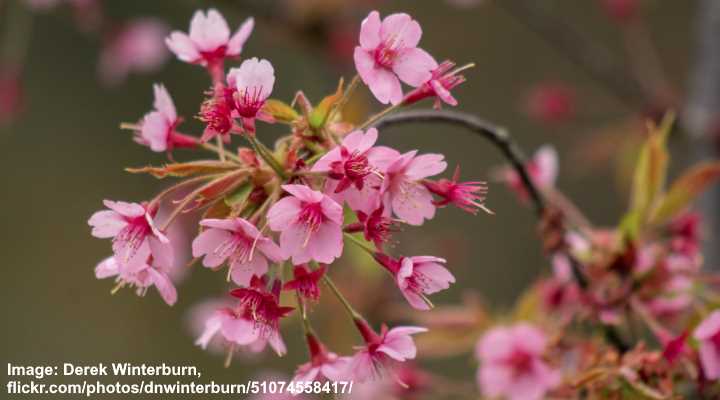
Prunus ‘Kursar’ is a dwarf cherry blossom tree that is suitable for landscaping compact gardens
The Prunus ‘Kursar’ is a pink dwarf cherry blossom tree with clusters of deep pink single flowers that bloom in early spring. The stunning cherry flowers appear on bare branches, creating an eye-catching floral display of intense color. This beautiful ‘Kursar’ flowering cherry tree is slow-growing and reaches a mature height of 6.5 ft. (2 m) after ten years.
Ideal tree for compact garden landscapes, the blossoming dwarf cherry ‘Kursar’ fills a backyard with color throughout the growing season. The tree’s ovate-shaped leaves emerge coppery-bronze before turning dark green and then orange in the fall.
The compact cherry blossom ‘Kursar’ is an ideal ornamental tree for growing in small spaces as it matures at 6.5 ft. (2 m) high and wide. It thrives in USDA zones 6 through 8 in full sun and well-draining, fertile soil. Plant as a lawn tree, specimen tree, or grow in containers as a beautiful patio tree.
Dwarf Cherry Blossom Tree ‘The Bride’ (Prunus incisa ‘The Bride’)
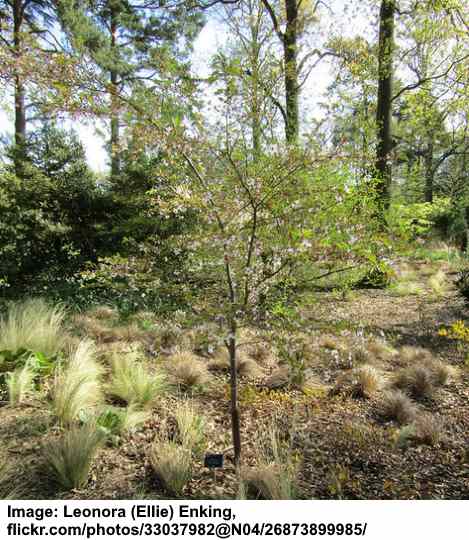
The small cherry blossom tree ‘The Bride’ has white flowers with red centers and thrives in full sun
Prunus incisa ‘The Bride’ is a small white cherry blossom tree with masses of single snow-white flowers blooming in early spring. The stunning white, 5-petaled papery flowers have contrasting bright red centers, making the cherry floral display more spectacular. Flowering cherry ‘The Bride’ grows up to 10 ft. (3 m) tall and wide.
‘The Bride’ cherry blossom tree has medium-green, ovate leaves that create a shade canopy on a spreading, rounded crown. In the fall, the cherry tree’s foliage turns warm autumn shades of orange and red. The best feature of the cherry tree ‘The Bride’ is the open blooms with their large white and pink petals.
This low maintenance white flowering cherry tree thrives in USDA zones 5 through 8. The cherry blossom tree grows best in full sun as a stunning lawn tree. However, the dwarf cherry tree is small enough to grow in containers.
Dwarf Flowering Fuji Cherry Tree (Prunus incisa ‘Kojo-No-Mai’)
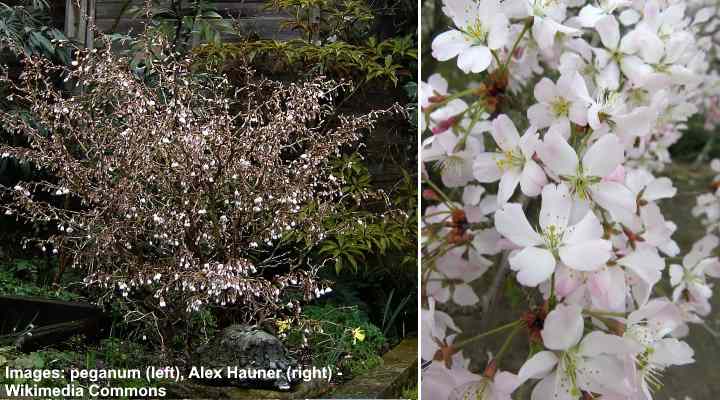
Fuji cherry tree (Prunus incisa ‘Kojo-No-Mai’) is small enough to be grown in a container
The Fuji cherry blossom tree is a small flowering tree with dangling clusters of small pinkish-white flowers. Like many Japanese cherry blossom trees, delicate papery flowers appear on bare branches. After the cherry tree blooms, lance-shaped, dark-green leaves create a spreading rounded crown of dense foliage.
The Fuji cherry blossom tree grows best in gardens in USDA zones 6 through 8.
The Prunus incisa ‘Kojo-No-Mai’ is a dwarf cherry blossom tree suitable for small front yards, backyards, or growing in pots. The slow-growing, compact white cherry blossom matures around 8 ft. (2.4 m) tall and wide. This stunning flowering tree is ideal as a specimen plant, lawn tree, potted tree, or planting in rock gardens.
Snow Fountain Small Cherry Blossom Tree (Prunus serrulata ‘Snow Fountain’)
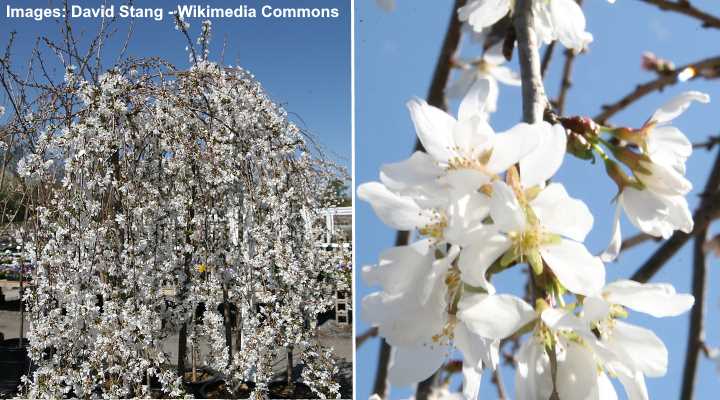
Weeping cherry blossom tree ‘Snow Fountain’ adds a beautiful focal point to a small or large garden
The white cherry blossom tree ‘Snow Fountain’ is a stunning example of a deciduous dwarf weeping tree. The cascading branches bloom with masses of white flowers in mid-spring. The arching branches droop down to the ground, and the white cherry blossoms make the small weeping tree look like a ‘snow fountain.’
The white dwarf cherry blossom tree grows between 8 and 15 ft. (2.4 – 4.5 m) tall. After the white blooms have finished, dark green, ovate leaves emerge on the long, drooping branches. The ‘Snow Fountain’ cherry tree turns warm golden yellow and orange hues in the fall. As with most ornamental cherry trees, this weeping cultivar produces inedible small dark red or black fruits.
Other names for the Prunus serrulata ‘Snow Fountain’ include ‘Snofozam,’ weeping higan cherry, and Prunus ‘White Fountain.’
In USDA zones 5 through 8, the ‘Snow Fountain’ cherry blossom tree is a stunning lawn tree in small gardens. The trailing flowering branches also spread out over the ground and can be used as ground cover or cascading over walls.
Japanese Dwarf Cherry Blossom Tree (Prunus serrulata ‘Kiku-Shidare-Zakura’)
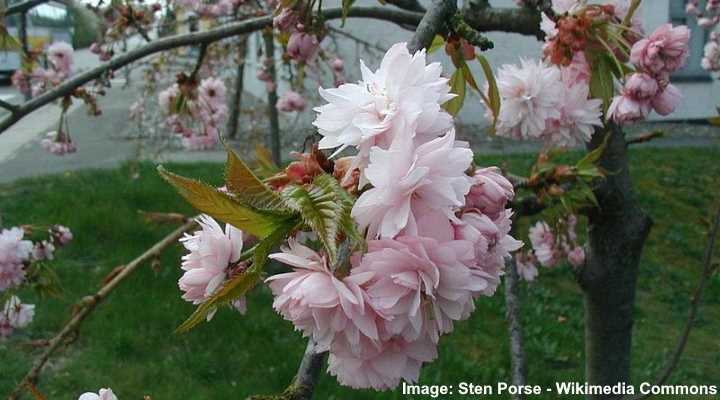
Japanese dwarf weeping cherry ‘Kiku-Shidare-Zakura’ has stunning pink double flowers
The sakura dwarf weeping cherry blossom is a spectacular small tree when it’s in bloom. The showy pink blooms are double flowers consisting of ruffled petals that dangle from cascading branches. When in full bloom in mid to late spring, the large pink cherry flowers emit a sweet, pleasant scent.
The botanical name ‘Kiku-Shidare-Zakura’ means weeping chrysanthemum cherry in Japanese. The showy, double pink flowers on this cherry tree look like chrysanthemum flowers. The large powder puff flowers have up to 125 petals in each flower head. The spectacular pink flowers dangle in clusters of drooping stems, creating a breathtaking floral display.
Other features of the small ornamental Japanese flowering cherry tree are its coppery peeling bark, bright green serrated, pointed leaves, and beautiful orange-red fall foliage.
The Japanese weeping oriental cherry tree thrives in USDA zones 4 – 9. Grow as a specimen tree, lawn tree, or container plant in full sun and well-draining soil.
Hiromi Dwarf Cherry Blossom Tree (Prunus jacquemontii ‘Hiromi’)
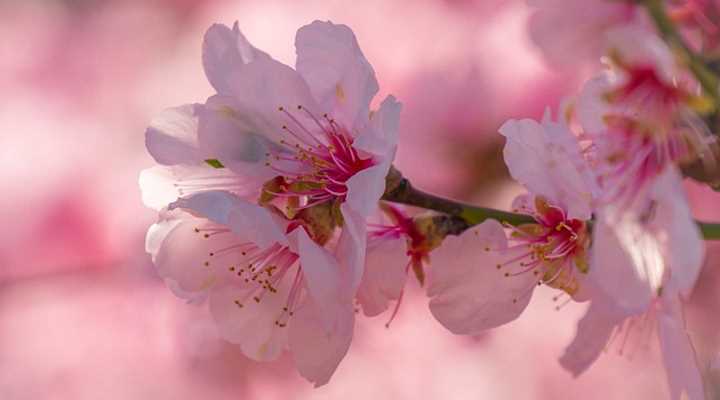
The very small size of Prunus jacquemontii ‘Hiromi’ makes it ideal for compact spaces
The Hiromi dwarf cherry blossom is one of the smallest ornamental cherry trees. The beautiful fragrant pink cherry tree flowers have bright red centers. The mini cherry tree blooms in early spring. After the flowers drop, bright green leaves and red cherry fruits appear. The fall color of the Hiromi cherry tree is bright golden-yellow.
The stunning ‘Hiromi’ cherry tree grows between 3 and 5 ft. tall (1 – 1.5 m) and up to 4 ft. (1.2 m) wide. The erect, spreading branches become spikes of pinkish-white colors when the small cherry tree blooms in early spring.
‘Hiromi’ cherry blossom trees are ideal as small specimen trees for landscaping compact backyards or front yards. You can also plant the flowering shrubby tree as a hedge, privacy screen, or as a landscaping plant for the front of house. Other names for the ornamental ‘Hiromi’ cherry blossom tree include Afghan dwarf cherry, bush cherry, and flowering almond.
Growing in USDA zones 4 through 8, the small, low-maintenance cherry tree is easy to grow in most gardens and a wide range of soil types.
Small Weeping Cherry Blossom Tree (Prunus x subhirtella ‘Pendula Rubra’)
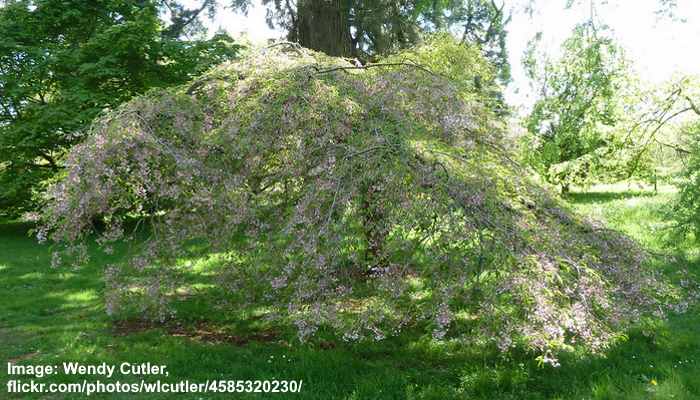
Prunus x subhirtella ‘Pendula Rubra’ is a weeping dwarf cherry blossom tree
The cherry tree ‘Pendula Rubra’ is a compact pink weeping cherry tree with masses of carmine-pink flowers. The single flowers grow in clusters on pendulous branches that create a cascading flow of pink colors. In late spring, the weeping cherry produces ovate green leaves that turn bright hues of orange and red in the fall.
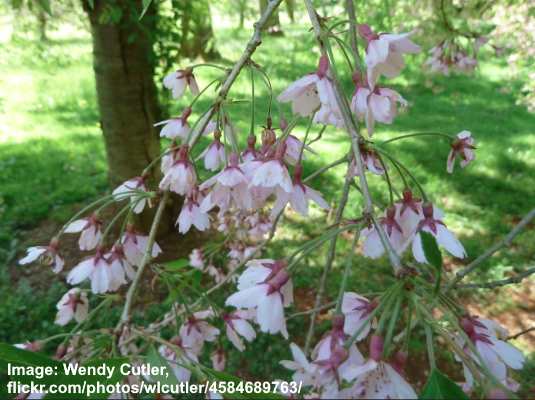
Close up picture of Prunus x subhirtella ‘Pendula Rubra’ flowers
The ‘Pendula Rubra’ weeping cherry blossom tree grows up to 10 ft. (3 m) high and 10 ft. (3 m) wide. Thanks to its compact growth, the mini pendulous cherry tree is an ideal tree for small gardens, tight spaces, or growing in pots on a balcony or patio.
The small deciduous cherry tree with arching branches grows in full sun and moist, well-draining soil. As a slow-growing tree, the cherry ‘Pendula Rubra’ takes ten to 20 years to reach maturity.
Small Pink Cherry Tree (Prunus ‘Okame’)
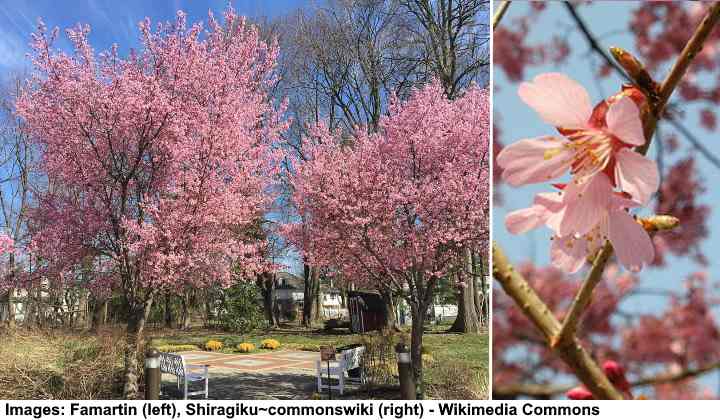
The small Okame cherry blossom trees are slow growers and prefer full sun
The Prunus ‘Okame’ is a dwarf ornamental cherry tree with pink blossoms that emerge in early spring. The irregular crown and spreading branches of this small cherry blossom tree create a spectacular colorful attraction in spring. Serrated green leaves cover the tree in summer before becoming fiery orange-red in the fall.
The ‘Okame’ flowering cherry tree is slow-growing and takes up to 20 years to reach its mature height of 13 ft. (4 m). The small tree is ideal for planting in sunny yards, regardless of size. The clusters of small candyfloss-pink flowers brighten up any spring garden.
Plant the small ‘Okame’ cherry blossom tree in USDA zones 6 through 8. Like all varieties of ornamental cherry trees, this small cherry tree prefers full sun and moist, well-drained ground.
Small Hillings White Cherry Blossom Tree (Prunus ‘Snow Showers’)
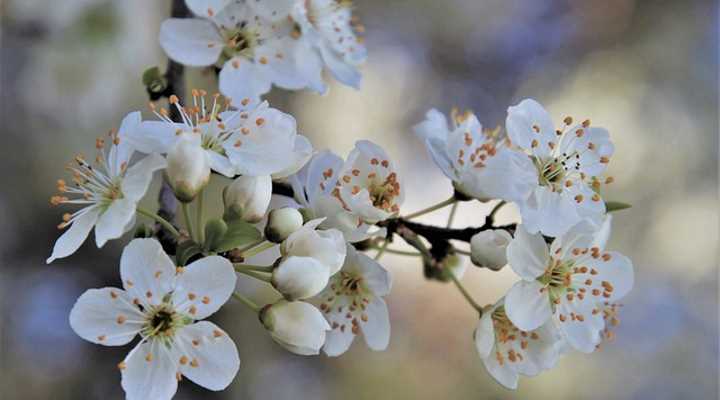
The small Prunus ‘Snow Showers’ tree has white flowers on weeping branches
The Prunus ‘Snow Showers’ is a dwarf white weeping cherry blossom tree with snow-white blossoms covering drooping branches. The snowy white flowers bloom in March and April, creating a cascading mound of white flowers. This dwarf flowering cherry tree grows up to 10 ft. (3 m) tall and wide.
Also called the Hillings weeping tree, this cherry blossom plant thrives outdoors in USDA zones 4 through 8. Growing in full sun and moist, well-drained soil, the Prunus ‘Snow Showers’ is an ideal small flowering tree.
You can plant the ‘Snow Showers’ cherry blossom tree as a specimen tree, potted tree on the patio, or as mass plantings to create a flowering hedge.
Pink Cherry Blossom Tree (Prunus ‘Little Pink Perfection’)

Prunus ‘Little Pink Perfection’ has beautiful pink double flowers
The Prunus ‘Little Pink Perfection’ is a pink dwarf flowering cherry tree with showy pink double flowers that bloom during April and May. The delightful dwarf cherry blossom tree also has green, lance-shaped leaves that turn shades of orange and red in the fall.
This decorative tree is a slow grower and is ideal for compact gardens, growing in a container, or as a specimen lawn tree. It can reach a height of 8 – 13 ft. (2.5 – 4 m) after 10-20 years, but typically grows to 5 x 5 ft. (1.5 x 1.5 m).
Prunus ‘Little Pink Perfection’ grows in most soil types. You can grow this ornamental cherry tree in USDA zones 6 through 8.
Where to Plant Small Cherry Blossom Trees
Grow dwarf cherry blossom trees in the ground in the sunniest part of your garden. Flowering cherry trees generally require between six and eight hours of sunshine daily. It’s also vital to plant ornamental cherry trees where they get enough air circulation.
How to Water Dwarf Cherry Blossom Trees
Dwarf cherry blossom trees need a good amount of water during spring and summer. Water the flowering tree enough to keep the soil moist but not waterlogged. It may be necessary to water a cherry blossom tree every three or four days in hot weather. You can hold off watering during winter.
The Best Soil for Flowering Dwarf Cherry Trees
Dwarf cherry blossom trees thrive in fertile, loamy soil that has excellent drainage. To fertilize the flowering cherry tree, add a good amount of compost in the spring. Organic matter in the soil increases acidity and boosts the soil’s nutrient levels. These are essential factors to ensure plenty of white or pink blossoms on the cherry tree.
How to Plant Small Flowering Cherry Trees
To plant a dwarf cherry tree, dig a large hole in the ground, large enough to accommodate the bare-root tree. Ideally, the hole should be three times the size of the root ball but not deeper. Make sure the soil line on the trunk is in line with the ground. Fill in the hole with organically rich soil, press down, and water thoroughly.
After planting a small cherry blossom tree, put a layer of mulch around the root area.
Pruning Dwarf Cherry Blossom Trees
Due to their small size, dwarf cherry blossom trees rarely need pruning. Dwarf cherry trees are cultivated to have a rounded, weeping, or spreading growth that doesn’t exceed 10 ft. (3 m) tall and wide.
However, you can prune a dwarf cherry tree during the first few years to create an attractive crown and branch framework. After three years, the only pruning required is to remove damaged or unwanted branches. Always prune after flowering in late spring.
Top tip to care for dwarf cherry blossom trees: Trim any shoots that appear on grafted stems and remove any suckers that appear at the root base.
Growing Dwarf Cherry Blossom Trees in Your Yard
Dwarf flowering cherry trees are a beautiful addition to a front or backyard of any size. The spectacular cherry trees provide all-year seasonal interest—pinkish-white spring blossoms, lush summer foliage, and eye-catching red and orange colors in the fall.
Watch out for aphids that can infest dwarf cherry blossom trees. Signs of aphids include curling leaves and a sticky substance on stems. To get rid of aphids, spray the ornamental cherry tree’s foliage with insecticidal soap or a neem oil solution.
Related articles:
